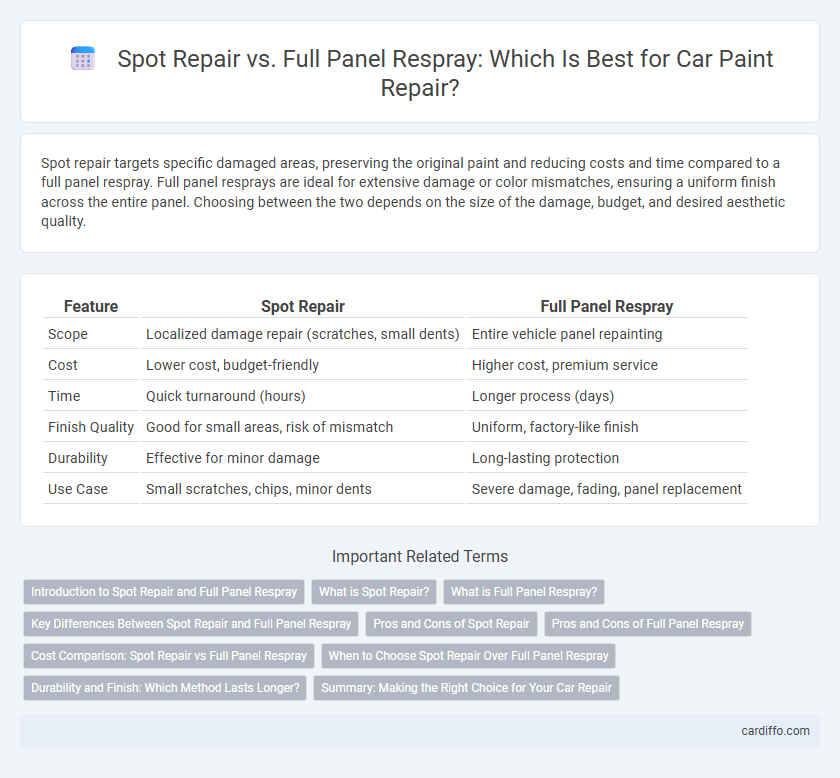Spot repair targets specific damaged areas, preserving the original paint and reducing costs and time compared to a full panel respray. Full panel resprays are ideal for extensive damage or color mismatches, ensuring a uniform finish across the entire panel. Choosing between the two depends on the size of the damage, budget, and desired aesthetic quality.
Table of Comparison
| Feature | Spot Repair | Full Panel Respray |
|---|---|---|
| Scope | Localized damage repair (scratches, small dents) | Entire vehicle panel repainting |
| Cost | Lower cost, budget-friendly | Higher cost, premium service |
| Time | Quick turnaround (hours) | Longer process (days) |
| Finish Quality | Good for small areas, risk of mismatch | Uniform, factory-like finish |
| Durability | Effective for minor damage | Long-lasting protection |
| Use Case | Small scratches, chips, minor dents | Severe damage, fading, panel replacement |
Introduction to Spot Repair and Full Panel Respray
Spot repair targets small, localized paint damage by applying color only to the affected area, preserving the original finish and reducing time and cost compared to full panel resprays. Full panel respray involves repainting an entire car panel, ensuring uniform color and finish, ideal for extensive damage or when color matching is difficult. Choosing between spot repair and full panel respray depends on the size of the damage, vehicle color complexity, and desired aesthetic outcome.
What is Spot Repair?
Spot repair targets localized paint damage or minor scratches by carefully sanding, filling, and repainting only the affected area, preserving the surrounding original paint. This method minimizes costs and reduces the time required compared to a full panel respray, which involves repainting an entire panel for larger or more severe damage. Spot repair is ideal for maintaining a vehicle's appearance with minimal disruption and material use.
What is Full Panel Respray?
Full panel respray involves repainting an entire car panel to restore uniform color and finish, especially when damage or fading affects large areas. This method ensures seamless coverage, eliminating mismatched paint and visible repair spots that can occur with partial touch-ups. It is ideal for maintaining the vehicle's aesthetic value and protecting the surface from further corrosion or wear.
Key Differences Between Spot Repair and Full Panel Respray
Spot repair targets specific damaged areas, offering a cost-effective and quicker solution by blending new paint with existing surfaces, ideal for minor scratches or dents. Full panel respray involves repainting the entire panel to ensure uniform color and finish, best suited for extensive damage or color mismatches. Key differences include the scope of coverage, finish consistency, time, and cost, with spot repair being less invasive and full panel respray providing a more seamless, long-lasting appearance.
Pros and Cons of Spot Repair
Spot repair offers a cost-effective solution by targeting only the damaged area, minimizing paint consumption and labor time. It preserves the original paint on the unaffected panels, reducing the risk of color mismatch often seen in full panel resprays. However, spot repair may not be suitable for extensive damage or areas with complex contours, potentially leading to less durable results compared to a full respray.
Pros and Cons of Full Panel Respray
Full panel respray offers a uniform finish and restores the vehicle's original color integrity, making it ideal for extensive damage or faded paint. The process can be more costly and time-consuming compared to spot repairs, often requiring the removal of trims and careful blending to avoid mismatched sections. However, it provides a more durable and aesthetically pleasing result, especially important for maintaining vehicle value.
Cost Comparison: Spot Repair vs Full Panel Respray
Spot repair typically costs 40-60% less than a full panel respray due to the smaller area of damage addressed. A full panel respray involves extensive labor, including sanding, masking, and blending, which significantly increases material and labor expenses. Choosing spot repair can therefore provide a cost-effective solution for minor paint blemishes without compromising the vehicle's overall appearance.
When to Choose Spot Repair Over Full Panel Respray
Spot repair is ideal when addressing minor scratches, chips, or localized paint damage, as it preserves the original paint and reduces costs. Choosing spot repair over a full panel respray is efficient when the affected area is small and color matching technology ensures seamless blending with existing paint. This approach minimizes downtime and maintains vehicle value by avoiding extensive refinishing.
Durability and Finish: Which Method Lasts Longer?
Spot repair targets localized damage, preserving the surrounding factory paint with minimal disruption, resulting in a finish closely matching the original and offering decent durability for small areas. Full panel respray involves repainting the entire panel, ensuring uniform color and texture with enhanced protection against environmental factors, typically providing a longer-lasting finish. While spot repairs are cost-effective and quicker, a full panel respray generally offers superior durability and a more seamless, long-term finish.
Summary: Making the Right Choice for Your Car Repair
Spot repair targets localized damage such as scratches or small dents, offering a cost-effective and time-efficient solution that preserves most of the original paint. Full panel respray involves repainting an entire car panel, ensuring color consistency and durability, especially for extensive damage or fading. Choosing between spot repair and full panel respray depends on the severity of the damage, budget considerations, and desired aesthetic outcome.
Spot repair vs full panel respray Infographic

 cardiffo.com
cardiffo.com